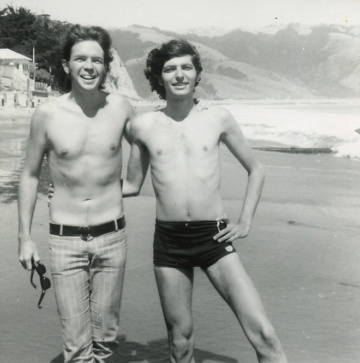Meanwhile, across the bay in San Francisco, the commingling of several activities helped to prepare the ground for the remarkable literary explosion that was soon to take place. The Libertarian Circle held regular literary events; poet members included Kenneth Rexroth, Muriel Rukeyser, William Everson, Robert Duncan, Jack Spicer, and Thomas Parkinson. Rexroth also ran a literary program on KPFA, the country’s first listener-sponsored radio station. Madeline Gleason (assisted by Rexroth and Duncan) founded the San Francisco Poetry Center, housed at San Francisco State College and managed by Ruth Witt-Diamant. The magazines Circle, Ark, City Lights, Goad, Inferno, and Golden Goose helped to consolidate the growing literary underground.
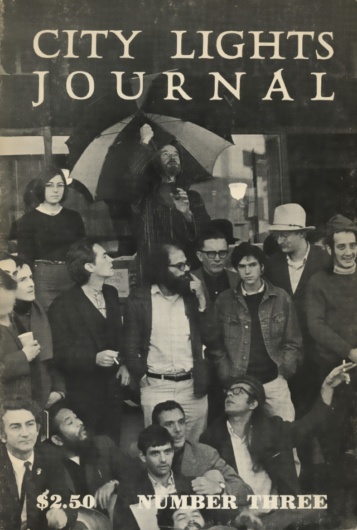
City Lights Journal 3 (1966), edited by Lawrence Ferlinghetti. Front cover: Poets at City Lights Bookstore, December 5, 1965 (photo by Larry Keenan, Jr.). Back row, left to right: Stella Levy. Lawrence Ferlinghetti (with umbrella). Next row, left to right: David Meltzer (with scarf over shoulder), Michael McClure, Allen Ginsberg, Daniel Langton, Steven Bornstein, Richard Brautigan, Gary Goodrow in jester hat. Front row, sitting down, left to right: Robert LaVigne, Shigeyoshi Murao, Larry Fagin, Lelan Mevezove (in Larry Fagin’s lap), Lew Welch, Peter Orlovsky.
The famous reading at Six Gallery on Fillmore Street was publicized by Allen Ginsberg (via a hundred mailed postcards and a few flyers) thus: “6 POETS AT 6 GALLERY Philip Lamantia reading mss. of late John Hoffman—Mike McClure, Allen Ginsberg, Gary Snyder & Phil Whalen—all sharp new straightforward writing—remarkable collection of angels on one stage reading their poetry. No charge, small collection for wine and postcards. Charming event. Kenneth Rexroth, M.C. 8 PM Friday Night October 7, 1955 6 Gallery 3119 Fillmore St. San Fran.“ On October 7, 1955, in a room measuring 20 x 25 feet with a dirt floor, Ginsberg “read Howl and started an epoch.” [4] Gary Snyder, Philip Lamantia, Michael McClure, and Philip Whalen shared the bill and, by all reports, also read brilliantly. Aside from Rexroth and Whalen, all the readers were in their twenties. Again, in the words of Kenneth Rexroth, ”What started in SF and spread from there across the world was public poetry, the return of a tribal, preliterate relationship between poet and audience.” [5]
These events, along with the flourishing of Lawrence Ferlinghetti’s City Lights Bookshop and publishing house, helped to inaugurate and consolidate what has become known as the San Francisco Renaissance. City Lights published Howl in 1956 (Ferlinghetti asked Ginsberg for the manuscript the same night it was read at the Six Gallery) as Number Four in the Pocket Poets Series. (It had been preceded by an extremely rare mimeographed edition, typed by Martha Rexroth and mimeographed by none other than Robert Creeley. Ginsberg’s Siesta in Xbalba had been mimeographed by the man himself on a freighter in the Alaskan Ocean.) Among the audience members that night was one who added his own chant, the young novelist Jack Kerouac, whose On the Road, published in 1957, was to make this reading and its readers legendary.
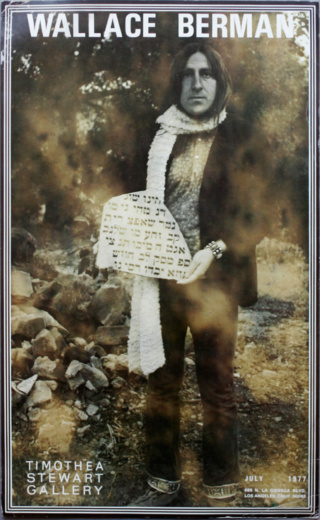
Poster for Wallace Berman’s July 1977 retrospective exhibition at the Timothea Stewart Gallery, Los Angeles.
It was also in 1957 that Charles Olson, rector of the experimental Black Mountain College, visited San Francisco and gave a series of lectures on Alfred North Whitehead at the Portrero Hill home of Robert Duncan and his companion, the painter Jess Collins. Among the attendees at the lectures were, of course, Duncan himself, but also Michael McClure, Gary Snyder’s Reed College friend Philip Whalen, Jack Spicer, and Richard Duerden. The same year saw the “San Francisco Scene” issue of Evergreen Review. Poet Helen Adam’s flamboyant 1961 ballad opera, entitled San Francisco’s Burning, epitomized the time, outrageous both aesthetically and socially. Other writers associated with the San Francisco Renaissance included James Broughton, Lew Welch, Ron Loewinsohn, Madeline Gleason, David Meltzer, Kirby Doyle, and Lenore Kandel.

Beatitude 17 (October–November 1960). Edited by Bob Kaufman, William J. Margolis, and John Kelly. Cover photograph by Fortunato Clementi.
Experimentation with forms of literature and lifestyle had long been an attractive characteristic of life in San Francisco. But the tolerance felt in Northern California was not as evident in Los Angeles. In 1957, an exhibit of work by assemblage artist Wallace Berman at the Ferus Gallery was closed by the Los Angeles Police Department, and Berman was jailed on charges of exhibiting “lewd and lascivious pornographic art.” Found guilty (by the same judge who ruled against Henry Miller), Berman and family left L.A. for San Francisco that year. Berman edited and published a fascinating assemblage magazine called Semina. After the raid of his exhibit at Ferus, he announced in Semina 2 that “I will continue to print Semina from locations other than this city of degenerate angels.” Berman’s friend, artist George Herms, designed his own books and provided the artwork for others, including Diane di Prima. Herms had likewise found the political climate in L.A. intolerable and had preceded the Bermans to Northern California.
Continue readingIn the mid-1960s, John Martin’s Black Sparrow Press began publishing broadsides and booklets and has, over the years, published a wide variety of experimental and alternative poetry and prose, including work by Duncan, Olson, Spicer, and Creeley, among very many others. After an impressively long run, Martin closed the press in 2002.
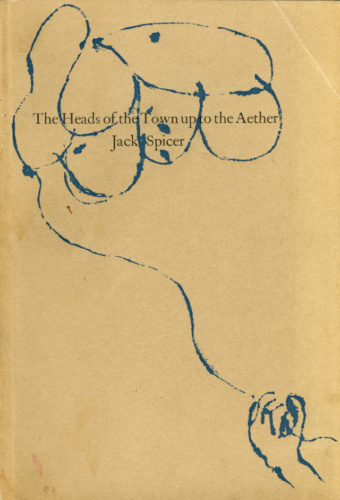
Jack Spicer, Heads of the Town up to the Aether (San Francisco: Auerhahn, 1962). Cover by Fran Herndon.
Because of the previous associations of house printer/designer Graham Mackintosh, Black Sparrow is linked to earlier literary small presses of Northern California, particularly White Rabbit Press (at the urging of Jack Spicer, Mackintosh resurrected the press in 1962, printing Spicer’s own Lament for the Makers); Robert Hawley’s Oyez Press (Mackintosh had printed its first book in 1963); and Dave Haselwood’s Auerhahn Press, which flourished during the 1960s and early ’70s in San Francisco. Auerhahn published a wide variety of well-designed books, including The Exterminator, an early example of William S. Burroughs’s and Brion Gysin’s cut-up technique, in 1960. Auerhahn also published John Wieners’s first book, The Hotel Wentley Poems. Oyez published many memorable volumes, including Philip Lamantia’s Touch of the Marvelous. Joe Dunn’s White Rabbit Press, which had begun publishing in 1957 with Steve Jonas’s rough work Love, the Poem, the Sea & Other Pieces Examined, produced books somewhat less elegant than Auerhahn’s or Oyez’s but with a beauty all their own.
The editorial genius behind White Rabbit was the irrepressible Jack Spicer, who published his own remarkable mimeographed magazine, J. Spicer emphasized the inclusion of writers who were not well published elsewhere, and accepted contributions for consideration in a box that was kept in one of three bars in the North Beach area of San Francisco. J is representative of the best of the mimeograph revolution: an uncompromising editorial stance combined with a playful, even colorful, formal character thanks to Fran Herndon, who edited the artwork for the magazine.
Spicer’s model for J was Beatitude, which had begun publication in San Francisco slighty before J. And a recalcitrant model it was, since Spicer was not a fan of the Beats and carried on a running war against Ferlinghetti in particular. He imagined Ferlinghetti had become commercial and financially successful, thereby, in Spicer’s mind, “selling out” to the establishment. Magnificently consistent with his principles, Spicer never copyrighted his own work, anticipating the “no copyright, no nuthin” statements of Tom Clark’s London-based Once series. The performative aspects of Spicer’s poetics as well as his personality also prefigured the rise of poetry readings in the 1950s, particularly those sponsored by the Poetry Center at San Francisco State, which featured mimeographed programs and booklets printing selections from the poets who were reading, among them, Charles Olson, Denise Levertov, and Louis Zukofsky.
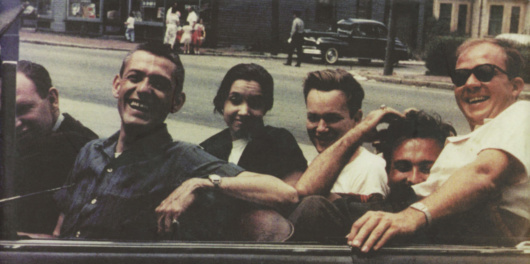
Left to right: Jack Spicer, Robin Blaser, Carolyn Dunn, Joe Dunn, Robert Duncan, Dick Bratset, probably in Newburyport (on the way from Boston to Cape Ann), probably spring 1965. Photograph by Kent Bowker.
Although Spicer’s J didn’t publish the works of “established” poets, Spicer did include the work of Robert Duncan in four issues of his magazine. Duncan and Jess Collins (whose work adorned the cover of many magazines and books of the period, including Open Space, Caterpillar, and The Floating Bear) were important influences on the literary and artistic scene in San Francisco in the ’60s. Duncan’s early work was published in Berkeley or North Carolina (his Song of the Borderguard was published by the Black Mountain College Press with a cover by Cy Twombly in 1952).
Other earlier works were multilithed (Fragments of a Disorderd Devotion in San Francisco in 1952) or mimeographed (the first hundred copies of Faust Foutu were mimeographed by Duncan himself, and the next 150 or so of one act of the play were multilithed by Joe Dunn of White Rabbit Press at his place of employment, the Greyhound Bus offices in San Francisco). The multilithed third edition of Faust Foutu, although also produced by Dunn, was published under Duncan’s own imprint, Enkidu Surrogate, of Stinson Beach. Duncan’s work was published by an amazing variety and number of publishers, including Oyez, Auerhahn, White Rabbit, Black Sparrow, Divers Press, Jargon, Perishable Press, City Lights, Grove Press, New Directions, and Scribners.
Slightly outside the Spicer circle (although some of his own poems were published in J) was Donald Allen, who, after the publication of The New American Poetry, 1945–1960 and before his removal to New York, established the Four Seasons Foundation in San Francisco, which published the work of a number of the writers from the anthology, including Charles Olson, Ed Dorn, Ron Loewinsohn, Philip Lamantia, Michael McClure, Joanne Kyger, Robin Blaser, and Robert Creeley. Among the early Four Seasons publications were two important works by poet Gary Snyder (the Reed College roommate of Lew Welch and Philip Whalen and the “Japhy Ryder” of Kerouac’s The Dharma Bums): Six Sections from Rivers and Mountains Without End and Riprap and Cold Mountain Poems, both published in 1965. Riprap, it should be noted, was originally published in 1959 as a booklet by Cid Corman’s Origin Press. Snyder’s Myths and Texts was published in 1960 by Corinth Books.
Snyder was out of the country on an extended stay in Japan, and the text used for the Corinth publication was probably from a manuscript that LeRoi Jones had hand-copied from one that Robert Creeley had received from Snyder in 1955 or 1956. Snyder’s poetry was extremely popular in the ’60s and was often used as text for broadsides by small presses, particularly those whose owners were ecologically minded. For instance, Snyder’s poem “Four Changes” was published in 1969 by Earth Read Out, a Berkeley environmental protection group, as four mimeographed pages, as well as in a folded, printed version in 200,000 copies by environmentalist Alan Shapiro for free distribution to schools and citizens’ groups.
Literary scenes with strong affiliations to the New American Poetry were in evidence elsewhere in California—most notably Bolinas in the 1970s, when that somewhat remote hippie village north of San Francisco became home to many poets. In particular, the transplanted easterner and Poetry Project veteran Bill Berkson and his press Big Sky flourished there in the decade, publishing both a magazine and a series of books. Bolinas residents of the period also included Robert Creeley, Bobbie Louise Hawkins, David Meltzer, Lewis Warsh, Tom Clark, Lewis MacAdams, Philip Whalen, Aram Saroyan, Joanne Kyger, Jim Carroll, and Duncan McNaughton, among others. Ted Berrigan, Alice Notley, and Joe Brainard were among many occasional visitors, with Joe Brainard’s Bolinas Journal providing an interesting record of one such extended stay.
Citations:
4. Kenneth Rexroth, American Poetry in the Twentieth Century (New York: Herder and Herder, 1971), p. 141.
5. Ibid.



